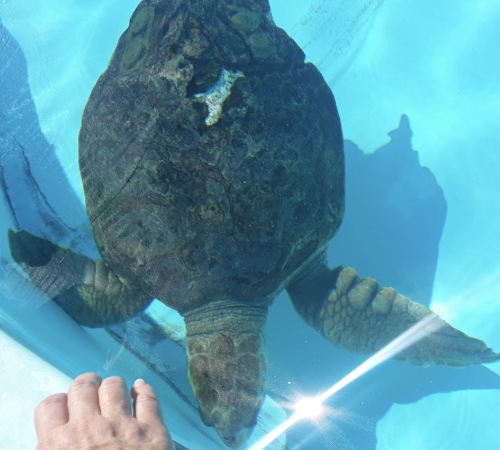Sea Turtles Won’t Survive the ESA Amendments Act

Sea Turtles Won’t Survive the ESA Amendments Act
About Sea Turtles
Sea turtles are some of the most amazing creatures in our oceans. As keystone species for the world’s waters, these beautiful reptiles keep plankton species in check along with cleaning and maintaining coral reefs and grass beds. Six species of sea turtles live in the oceans surrounding the United States: green, loggerhead, Kemp’s ridley, leatherback, hawksbill, and olive ridley turtles. Nearshore and offshore in-water habitats provide foraging grounds, migratory corridors, mating grounds, and shelter for sea turtles. Many of them make their nests on beaches in places like Florida – where 90% of sea turtles nest in the U.S. – and in locations including Hawaii, Texas, Puerto Rico, the Virgin Islands, Alabama, Georgia, South Carolina, and North Carolina.
Like people, sea turtles eat a variety of foods. Some species prefer foods that are see-through and transparent in water, like jellyfish and algae. Because these foods are easily mistaken for floating plastic pollution, one cause of sea turtle endangerment is the accidental consumption of ocean-bourne plastics.
Boat strikes are another major threat to sea turtles. Sea turtles need to come up to the surface to breathe, and that’s when fast-moving boats can hit them. Many sea turtles don’t have time to get out of the way, especially in busy areas with lots of boat traffic. The blunt-force trauma from a boat strike is usually deadly for sea turtles.
The top danger to sea turtles comes from commercial fishing activity. Large fishing industries use nets and hooks that accidentally trap sea turtles. These turtles can’t escape and often drown because they can’t get to the surface to breathe.
Protecting Sea Turtles
Sea turtles are protected under the Endangered Species Act (ESA), one of the strongest conservation laws in the world! The Endangered Species Act (ESA) is a U.S. law passed in 1973 to protect animals and plants that are at risk of extinction. Its main goals are: prevent extinction of endangered and threatened species, protect and restore habitats critical to those species, and promote recovery so species can eventually be removed from the endangered list. The law is administered by two federal agencies: the U.S. Fish and Wildlife Service (FWS) for land and freshwater species, and the National Marine Fisheries Service (NMFS) for marine species. The ESA prohibits harming listed species and requires federal agencies to ensure their actions don’t jeopardize them or their habitats.
There are two important parts of the ESA that help sea turtles today:
- Section 7 requires that any project (like construction near the beach or in the ocean) must avoid harm to sea turtles or the places where they live and nest. Thanks to this part of the law, the Atlantic green sea turtle population grew by 76% between 1979 and 2016!
- Section 9 makes it illegal to harm sea turtles or their eggs. This includes the illegal trading of their eggs. This illegal trade undermines decades of conservation efforts, as each stolen egg represents a lost chance for population recovery. As a result of this and other complications, wildlife agency officials, with help from people in the local community, carefully monitor beaches where sea turtles nest to protect them from activities that would hurt them. To protect sea turtles in the water, fishing boats must use special gear like turtle excluder devices, which help the turtles escape from nets. Boats also use special hooks and follow rules to reduce bycatch (accidentally catching turtles).
Another important rule is the Vessel Speed Rule, which sets slow zones for ships along the Atlantic coast. This protection is designed to reduce fatal ship strikes with North Atlantic right whales, but it helps other ocean animals that need to swim to the surface to breathe – including sea turtles.
The Problem with Proposals to Amend the Endangered Species Act
Recently, changes were proposed to the Endangered Species Act through the ESA Amendments Act of 2025. These changes could harm sea turtles in several ways:
Boat strikes could increase. The proposed elimination of vessel slow zones could lead to more turtles being hit by boats. When boats hit sea turtles, they usually suffer serious injuries. Some develop something called Bubble Butt Syndrome, where air gets trapped under their shell after a spinal injury. This makes it hard for them to dive for food or hide due to positive buoyancy, and many can’t survive in the wild.


Figure 1: Left: Image of sea turtle with Bubble Butt Syndrome, with weights on its back to aid in neutral buoyancy. Right: Image of sea turtle that was involved in a boat strike. (photo credit: Sarah Masters)
- Projects could get a pass to harm sea turtles and their nests. The changes would make it harder for wildlife agencies to stop projects from destroying sea turtle habitat. For example, beach construction or bright lights at night disturb nesting turtles, but these might not be stopped under the ESA amendments.
- “Conservation” might be replaced with “regulated taking.” This change would mean more fishing lines and nets in the water, increasing the chances of turtles getting caught or injured.
- Faster permitting, fewer protections. Developers would get speedy approval to build or change coastal areas, skipping science-based reviews of how projects impact sea turtles. This makes it harder to protect the nesting grounds that are critical for recovering sea turtle populations.
If legal protections are changed by the U.S. Congress, recovering sea turtles who have benefited from human interventions under the ESA may be at great risk of extinction due to failure to implement conservation practices that will support sea turtle survival.
What You Can Do to Help
- Contact your representatives in Congress. Let them know that you care about protecting sea turtles and keeping the ESA strong. Send an email today!
- Send sea turtle postcards to policymakers. You can help educate your friends, family or community and take action at the same time by hosting a postcard writing party. Find postcards and toolkits here.
-
- Join conservation efforts. You can volunteer to clean up trash in waterways near you to help stop plastic from making it to the ocean. You can also support sea turtle research and conservation organizations such as the Sea Turtle Conservancy (conserveturtles.org).
Sea turtles have come a long way, but they still need our help. We must make sure that the laws protecting them stay strong.
The post Sea Turtles Won’t Survive the ESA Amendments Act appeared first on Endangered Species Coalition.



Responses